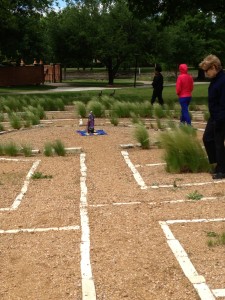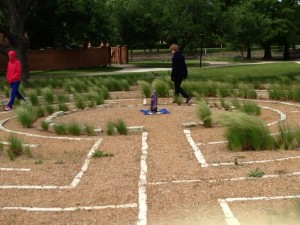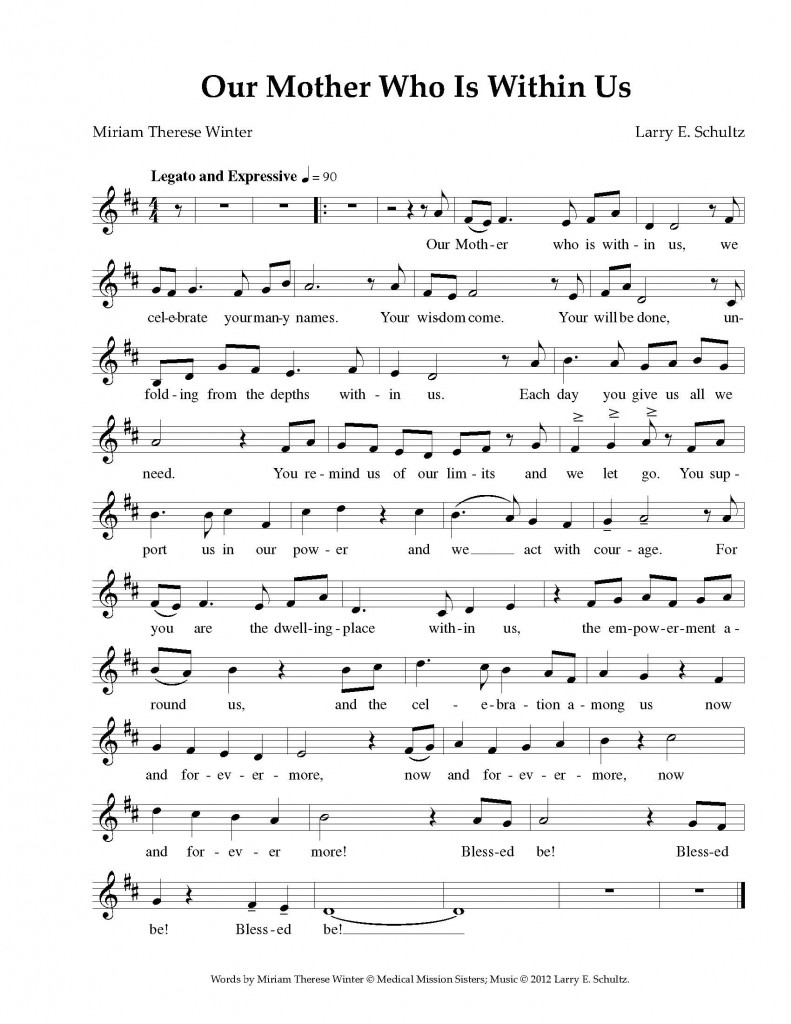“Walking the Labyrinth” Ritual, created by Florence Quillin for New Wineskins Community

WALKING THE LABYRINTH
NEW WINESKINS, MAY 5, 2013
OPENING HYMN: Stanza 1: “Christ-Sophia Now We Praise,” to tune of “Hark the Herald Angels Sing.”
Christ-Sophia now we praise; joyful songs our voices raise, for new life in us to birth, for deep healing of the earth. Long Her face we did not see; blind no more our eyes shall be; long we’ve needed Her embrace, glory and power of Her grace. Christ-Sophia now we praise; joyful songs our voices raise.Words © Jann Aldredge-Clanton
LEADER: “Walking the labyrinth fulfills six important contemporary needs: deepening spirituality; inwardness and connection; access to intuition and creativity; simplicity; integration of body and spirit; and intimacy and community.”
READER ONE: “Imagine Sardinia, 3,500 years ago. You are a mourner in a funeral procession, winding deep into the stone cavern of a burial chamber. Torches flicker in the tomb, throwing into high relief a petroglyph of a labyrinth. As the burial ceremony begins, you study the labyrinth for comfort in your grief, knowing it offers a map for death and rebirth for your deceased friend. This labyrinth shows you the circuitous route that your friend will follow into the tomb of Mother Earth. Your eyes rest for a moment at the center; know that this center will transform from tomb to womb, birthing your friend into her new life in the spirit realms back via the same winding route.”
READER TWO: “Imagine France, 800 years ago. You are in Chartres Cathedral near Paris. In this great vaulting cathedral you pause at the entrance to the stone labyrinth, recently inlaid so carefully into the floor of the nave. Looking up at the jewel-colored light streaming through the rose window high in front of you, you ask God/Goddess to bless your journey into the center of the labyrinth. You have prepared for this journey for months with prayer. This walk represents the dream of a lifetime: instead of making the pilgrimage to Jerusalem, too far and too dangerous, you walk this labyrinth now. You are on holy ground.”
READER THREE: “The labyrinth, with its circumambulation of and eventual arrival at the center through a single path, seems to have evolved from an archetypal symbol known in virtually every culture throughout time: the spiral, the universal symbol of growth and transformation.” (West, Melissa: Exploring the Labyrinth: A Guide for Healing and Spiritual Growth)
READER FOUR: “To walk a sacred path is to discover our inner sacred space; that core of feeling that is waiting to have life breathed back into it through symbols, archetypal forms like the labyrinth, rituals, stories, and myths.”
READER FIVE: “Why does the labyrinth attract people? Because it is a tool to guide healing, deepen self-knowledge, and empower creativity. Walking the labyrinth clears the mind and gives insight into the spiritual journey. It urges action. It calms people in the throes of life transitions. It helps them see their lives in the context of a path, a pilgrimage. They realize that they are not human beings on a spiritual path but spiritual beings on a human path.”
READER SIX: “When we are grounded in our bodies, we are stabilized and can receive information more accurately. Much like fine-tuning a radio, if we are attuned to our bodies the static in the incoming messages and impulses is reduced. To reclaim the body is a sacred act. In doing so, we may discover a path to the Divine. Dancing, skipping, crawling, or solemnly walking are all encouraged on the labyrinth. The more free and spontaneous we are in the labyrinth, the more energy we bring into our lives.”
READER SEVEN: “Sacred space is by definition the place where two worlds flow into each other, the visible with the invisible. The finite world touches the infinite. In sacred space we can let down our guard and remember who we are. The rational mind may be released. In sacred space we walk from chronos time to kairos time, as we allow our intuitive self to emerge.” (Artress, Lauren: Walking A Sacred Path: Rediscovering the Labyrinth as a Spiritual Practice)
HYMN: Stanzas 1 & 3: “Come to Me, All You with Heavy Hearts,” to tune of “Balm in Gilead”
REFRAIN: Come unto me, you weary ones, and I will give you rest; come, leave your burdens in my arms, and lean upon my breast. 1. We hear you, Christ-Sophia; our heavy hearts rejoice to bring our cares unto you, and heed your gentle voice. REFRAIN 3. You call us, Christ-Sophia, our spirits to revive; we learn from you the wisdom to keep our hope alive.” REFRAINWords © Jann Aldredge-Clanton
LEADER: Now we come to the actual walking of the labyrinth. Remember there is no RIGHT way to walk the labyrinth. You may think of walking in four movements:
READER EIGHT: 1. On the threshold: Pause to center yourself. Clear your mind and become aware of your breath. You will find a bowl of water there. Simply dip your fingers into the water to help cleanse your mind. There is also a small basket of herbs – take a sprig with you if you like or simply take in the aroma. Enter the path when you are ready.
READER NINE: 2. Journeying in: Allow yourself to find the pace your body wants to go. You may want to repeat a mantra, pray or leave your mind open to whatever comes. You may “pass” people or let others step around you, whichever is easiest. The path is two-way; those going in may meet those coming out. Do what feels natural when this happens.
READER TEN: 3. Resting place: Here is a place where you can stop moving, be still, rest and breathe. Open your mind and heart to whatever gift you may wish to receive; it may be the gift of a word, a feeling, or just stillness. Be open to the experience.
READER ELEVEN: 4. Journeying out: When you feel ready to leave the center, give thanks for whatever you have received or found there and begin journeying out, following the same path you took on the journey in. You may find yourself energized and want to move at a faster pace. You may find yourself empowered to act on some new plan or idea your soul has been reaching for. When you reach the entrance (now the exit), pause, give thanks, and rest. You may want to sit under the trees and quietly ponder the experience. You may want to write or draw about it. There are pencils and paper available.
LEADER: We will gather again on the benches after the walk. You will then have an opportunity to share with our circle your thoughts and feelings about the labyrinth experience. If you choose, you may sit or walk around while others walk the labyrinth. There are labyrinth books to browse or you may prefer to sit quietly in meditation.
CLOSING: “Our Mother Who Is Within Us” (words by Miriam Therese Winter and music © Larry Schultz)

